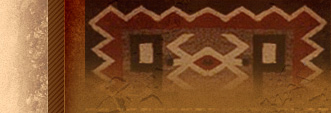 |
 |
| |
Mythic Ways of Knowing |
|
| |
"The stories we tell about our lives are not necessarily those lives as they were lived, but these stories become our experience of those lives. A published narrative of an illness is not the illness itself, but it can become the experience of the illness. " Read more ...
-- Arthur Frank
"My grandmother taught me respect for the environment and the old Navajo way of discipline and about the Beautyway. She said that all Creation begins at the center from within. " Read more...
-- Navajo weaver Jesse Monongye
"'Live,' Nietzsche says, 'as though the day were here.' It is not society that is to guide and save the creative hero, but precisely the reverse." Read more ...
-- Joseph Cambpell
|
|
| We use the term "myth" to refer to stories that express important Truths held by an entire culture or people. Mythic ways of knowing about the world and ourselves are expressed in Art, Music, Story, and Dream. Their richness reaches our deepest selves, to both express and shape who we are as living beings in a particular Place and time. |
|
Many scholars who have studied myths, including Joseph Campbell, Clarissa Pinkola Estes, and Carl Jung, feel that the most important myths are universal -- that they express basic Truths held by many if not all human beings, in many time periods and places. They explain this universality in several major ways, all of them keyed to a universality of human biology, history, and consciousness.
To Indigenous peoples, however, the common ground that produces the powerful symbols of myth and art is more than a collective human experience. Such myths or stories are universal because they emerge from the very fabric of the Earth itself, rising from its stones and soils the same way living things do. In this world view, art and story are real rather than representative, and the components referred to as "symbols" or "metaphors" by Western culture are instead parts of an actual whole.
Both cultural views of myth are powerful, though significantly different. In contemporary Modern worldview, reflecting on the myths we tell in image, film, music, and poetry allows us to catch sight of the deep-seated things our cultures hold to be True. They gives us the power to evaluate the myth and decide whether or not we actually believe it. As society changes, its ideals and concepts of right and wrong change -- and the myths are overturned or reformed as society explores new images and stories that tell the new Truths.
In Indigenous worldview, where mythic stories are told by the natural world as a fundamental aspect of its existence, human beings participate in the on-going story being told, through the lives they live. So in this worldview, mythic level art and story do not simply tell us about our culture and its beliefs; they help create and maintain a whole and healthy Reality, in both their telling and living-out.
It's appropriate to analyze Western or modern Arts within the worldview of symbol and metaphor, because that's the worldview the artists used to create their works. To explore an example of Western-cultural mythic knowing, visit Mythic Ways of Knowing about Tornadoes. The "tornado myths" explored there were produced by aritst and film-makers in contemporary culture, so that is the means used to explore them. But Indigenous arts should be understood within the worldview used by their creators.
Note: The Tornado link takes you to an older Tapestry webpage that has not yet been reformatted because of its high image content. Use the return button on your browser to return to this page when you have finished exploring the example.
|
| |
 |
|
|
|
 |
|
|

